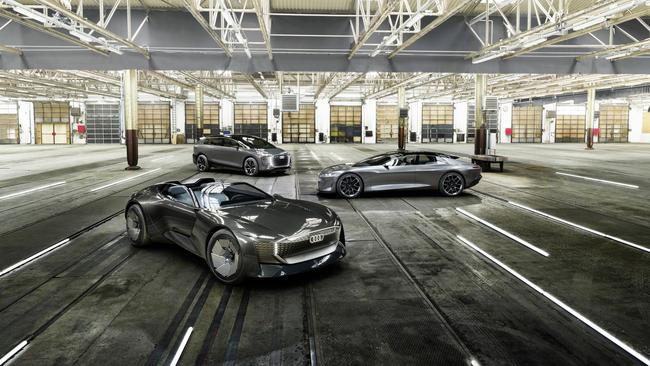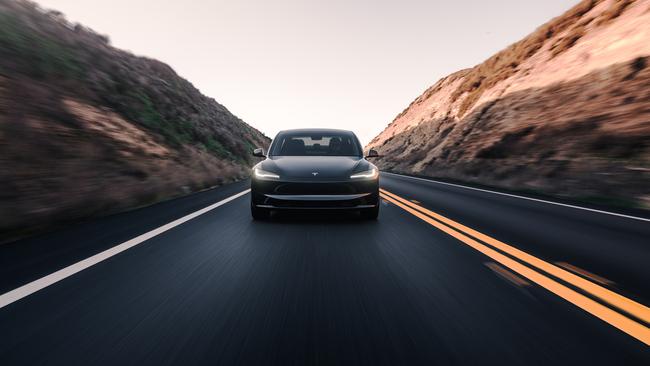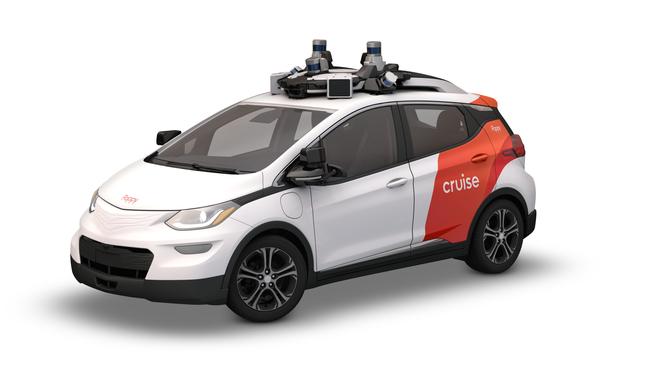Self-driving cars are having their ‘ChatGPT moment’
For all the hype, fully autonomous cars and robotaxis seemed to be years away. But it will only take the flick of a switch for everything to change.

If you are someone who loves driving, it might be best to look away now.
In the past year I have been rudely shaken by the twin terrors of asking ChatGPT to write an article that sounded like me (it was hilarious, but my tears of laughter were bitter) and going for a ride in a self-driving taxi around the streets of San Francisco.
Not only was my career in journalism suddenly on a Doomsday Clock countdown, but giving it all up to become an Uber driver was not going to be an option. Cars really are going to be able to drive themselves, with the help of AI, and sooner than a lot of us had hoped. It is a remarkable and vertiginous feeling, engaging with technology that has put an end date on not just your career but your life’s passions.
No lesser a genius than Elon Musk, who is essentially gambling the future of his EV company Tesla on the exponential growth in use of autonomous cars, said recently that “cars that are not autonomous will be like driving a horse and using a flip phone”.
And then it got worse, when I sat down with a fiercely intelligent Tesla executive, Daniel Ho, who has worked closely with Musk for more than a decade, to talk about his company’s Full Self Driving (FSD) technology. His belief, as someone whose Tesla drives him to and from work every day without him ever touching the steering wheel or pedals, is that autonomous cars “are about to have their ChatGPT moment”.
“The big shift has come from using neural networks – AI that is set up to learn much like a human brain – and the thing about AI is that it moves so fast, and every now and then you have these moments, what you might refer to as ‘ChatGPT moments’, where there’s this inflection point and a technology goes from being ‘OK’ to ‘insanely good’,” says Ho, who grew up in Melbourne and used to work at Ford.
“If I look at FSD three months ago to where it is today, it’s made such a huge improvement in that time, just incredible. I was speaking to one of my guys about how effective the recent work has been, he said it’s not even a case of FSD being faster in terms of iteration speed, the best way to describe the difference is that it’s gone from being impossible, to possible.”
At this point, Full Self Driving (which can cope with city streets, intersections and freeways, and asks only that you pay attention – check it out on YouTube, it’s scarily good) isn’t available on Teslas sold in Australia, because of our laws, but the Commonwealth, states and territories are working on a national framework to regulate vehicles with automated driving systems.
And it only takes the flick of a switch, and an over-the-air update, for Tesla owners willing to pay to access it (in America, the cost of a monthly FSD subscription was recently cut from $US199 a month to $US99).

But this is only the beginning of the end of driving, because Musk recently announced his plans for “Cybercab”, and showed off the ride-hailing app that owners will use to turn their cars into autonomous, night-shift taxi drivers, as Andrew Hawkins, transportation editor at The Verge, explains. “Musk has been promising this thing called the ‘Tesla Network’ since 2017, and once we have fully autonomous vehicles it would mean that your car, instead of losing value as soon as you buy it, will actually appreciate in value, because you’ll be able to earn passive income from it,” Hawkins says.
“You’ll go to sleep and you’ll be able to send your car out to go and start picking people up and doing taxi trips and earning you income.
“It’s very clear that Elon thinks this is something that’s going to define Tesla’s next stage of growth, this robo-taxi application.
“I don’t think it’s an exaggeration to say that he’s betting the entire company on this proposition that you will be able to have your own self-driving Tesla at some point in the future.”
I’ve heard all this before, of course, and laughed in the face of doom. In 2016 at the Paris Motor Show, an Audi executive insisted, on the record, that his company would have an A8 limousine for sale, within 12 months, offering full Level 4 autonomy – “hands-off, eyes-off, you can check your Tweets or read a newspaper, whatever you like.”
I laughed at his hubris then, just as I laughed when Musk said he would set up a company that would send satellites into space. And when he said he would actually build the Cybertruck.
Recently, Audi launched a concept car called the Grand Sphere, which is filled with screens and comfy chairs, hooked up for streaming and features no visible steering wheel (there’s one hiding in the dash, which can pop out if you want to get old school). Audi says it will have a production-ready version, probably called the Q9, ready for public sale by 2025.
Audi, and other companies including Mercedes-Benz, have actually had the technological ability to put self-driving cars on the road for some time. The A8 Audi launched in 2017 was planned to be fully autonomous, but no country in the world would let the company explore its full potential on public roads.
As far back as 2013, an autonomous Mercedes-Benz S Class was allowed to drive 100km across Germany, including on its autobahns, with no human intervention.
Audi spokesman Josef Schlossmacher says his company is confident that global authorities are ready to embrace a driverless future. “Audi expected autonomous driving to come sooner, the whole industry did, but the interaction with traffic authorities became more complicated than we expected,” he explains.
“With Level 4 autonomy, which means not having a steering wheel permanently available, it means the authorities will then have to accept that your car is able to make its way safely on its own. We are sure we can convince them that our cars will be safe in every aspect.”
And so we come to the curly question of safety. Robotaxi companies like Waymo, owned by Alphabet (the parent company of Google), has been running self-driving taxis in the US for four years and in that time they’ve driven more than 11,000 “rider-only” kilometres. Waymo claims its rate of crashes involving any injury over that distance was 85 per cent lower than “the human benchmark”.

And yet, when I took a journey with a Cruise autonomous taxi in San Francisco (at that point, Cruise was Waymo’s only competitor), staring open-mouthed at the empty driver’s seat and the steering wheel moving by a force I could only describe as witchcraft, I did not feel safe, I felt out of control (as well as out of a job).
On the one hand, as a mere human, I felt frightened by putting my life in the hands of something even more lacking in love and care than a taxi driver, but as a motoring journalist my terror was even deeper, because a self-driving car is such a clear existential threat. I was like ye olde blacksmith riding in a horseless carriage for the first time.
In my review of that Cruise experience, penned for the motoring pages of this magazine last year, I wrote that “the most striking thing about the experience was that, after as little as 20 minutes, it just felt so normal, almost inevitable. I used the seat-back screens to play pub trivia, and clapped a little when the car slammed on the brakes in plenty of time for a yellow light. During my ride, my brain leapt between being scared – at one stage the car changed lanes and accelerated suddenly and I yelled at it in fear, then realised how pointless that was – and impressed; the robotaxi managed to negotiate a four-way Stop intersection, which I’m not very good at.”
Cruise taxis, owned by car giant General Motors, are no longer cruising the streets of San Francisco. Following an accident in October last year, in which a female pedestrian was dragged more than six metres by a Cruise vehicle, the company grounded its entire 950-car fleet and California officials pulled the company’s permit to operate in the state.
GM is not giving up on Cruise, however, and it will soon have its taxis back testing in Phoenix, Arizona, while Waymo continues to expand, bringing its self-driving cabs to Los Angeles and Austin, Texas, this year.
Tesla’s Daniel Ho shrugs off my concerns about how unsafe I felt in an autonomous taxi, telling me it was something I’d just get used to the more time I spent engaging with the future. “As Elon has said, ‘It’s going to save lives if you get it right,’ and it will, because it’ll be better than the average driver, who is terrible, and it’s already, well, yes, it’s better than me,” Ho says, reluctantly. “It’s definitely safer than when I’m driving. I would say I’m a fairly confident driver, but I take risks that the FSD will not take. It drives at the speed limit, or a set speed; I don’t. It drives at a distance away from the car in front that is a safe distance to stop; I don’t. Or there will be a small gap in the traffic that I think I can make, but it’s risky; FSD wouldn’t do that.
“This last weekend, I was pretty much running FSD everywhere my wife and I went, you know, picking up groceries, running errands, I was just using FSD the entire way. The only time I was intervening, at all, was for potholes. It can’t see those yet, but it will be able to soon.
“It’s actually statistically, scientifically rational for the machine to drive. And the more machines there are driving at the same time, the less human error there will be, overall.”
A report from the National Highway Traffic Safety Administration in the US found that Teslas using either FSD or the less advanced Autopilot (that’s the one you are allowed to use in Australia – it offers simpler systems like Traffic Aware Cruise Control and Autosteer, which will adjust the steering to keep you within a clearly marked lane) have been involved in at least 13 fatal crashes, which have killed 14 people and injured 49.
The regulators found that even the brand names “Autopilot” and “Full Self Driving” were a problem, encouraging drivers to rely on the systems when they were supposed to remain ready to take over if their human eyes identified a dangerous situation.
Andrew Hawkins, from The Verge, points out that Tesla’s systems are only deemed Level 2 autonomy, “which means you have to stay focused on the road – you can’t check your phone or watch a movie. It’s not full self driving, despite how it’s being marketed.
“But the idea is that all these Teslas are out there, gathering data, and at some point they’ll flick a switch and every Tesla will be awarded this magical ability to to drive itself from door to door, without any interventions,” Hawkins adds.
His concern is that Tesla has ditched the kind of sensors you’ll see on a fully autonomous Waymo – spinning and flapping things that make it look like a car trying to breathe at the bottom of the sea – including LiDAR (Light Detection and Ranging), radars and ultrasonic sensors. “Elon decided a while ago that that was too complex and too expensive, so they’ve gone with a completely camera-only system, and his argument is that human beings are out there driving, we use our eyes, that’s our primary way that we drive, so the robot needs to be able to do the same,” Hawkins explains. “The only problem is there’s no fallback – if something fails there’s not another layer there, a safety net to prevent a massive failure.”
Mercedes-Benz points out that its latest EQS and S-Class models – which have recently become the first ever to win state approval to use Level 3 autonomous systems on roads in California and Nevada – use additional sensors that it considers indispensable for safe automated driving. “These include a LiDAR, a camera in the rear window and microphones for detecting emergency vehicles, as well as a road-wetness sensor in the wheel well.” The list of other redundant systems to “ensure manoeuvrability in the event one of these systems fails” goes on at some length.

Ho is right, of course: artificial intelligence will eventually be better, or at least safer, at driving than us. And cars like Audi’s Grand Sphere are the clearest clue as to what the next generation of vehicles will look like. Audi has set the vehicle up so that what you’re streaming at home can transfer to your phone for the walk to your garage, and then to the big, lush screens inside for your journey. Less driving, more screens – I believe this is a modern teenager’s idea of bliss.
I have been shocked to notice how few of my son’s friends have any interest in learning to drive, but I was more shocked when it hit me after my recent revelatory moments that it seems certain my son won’t be teaching his kids to drive at all. It will be as anachronistically amusing as me instructing him in how to program a VCR.
Something vital will be lost, however, and it goes beyond the fact that future generations won’t get to enjoy the next-generation Jeremy Clarkson ranting about which cars have soul and hating on those that don’t. The joy of driving, that heady mix of man and machine, skill and thrill, is going to fade into history.
I finished off my review of the autonomous taxi, published just short of a year ago, by saying: “The idea of robotaxis might seem impossibly futuristic, but in San Francisco that far-fetched future is already here. And I’ll happily go out on a limb and say we’ll all be riding in self-driving cars within the decade.”
Now, and it pains me greatly to say this, it’s going to happen in fewer than five years.
For the longest time, my older motoring colleagues have laughed at the suggestion that our jobs are about to go the way of the milkman, pointing out that fully autonomous cars are just too complex to ever work, that the sort of intelligence it would take to design such a machine is beyond any engineers.
But then AI had its ChatGPT moment and cars, it seems, will be the next frontier. b





To join the conversation, please log in. Don't have an account? Register
Join the conversation, you are commenting as Logout